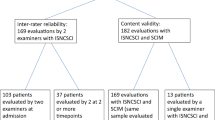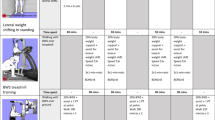Abstract
Study design
Longitudinal secondary analysis of observational data.
Objectives
To examine the effectiveness of physical (PT) and occupational therapy (OT) interventions in improving Spinal Cord Independence Measure III (SCIM III) scores among individuals with spinal cord injury (SCI).
Setting
Two SCI centers in Japan.
Methods
The content and time of rehabilitation interventions, and International Standards for Neurological Classification of SCI and SCIM III scores, were recorded at nine time points (72 h; 2, 4, and 6 weeks; and 2, 3, 4, 5, and 6 months after injury) for hospitalized individuals with SCI. Overall, 204 participants were included and categorized into four groups based on admission severity. Using a linear mixed-effects model, the effectiveness of PT and OT interventions — defined by the International Spinal Cord Injury Physical Therapy-Occupational Therapy Basic Data Set — was assessed using the SCIM III score as the dependent variable.
Results
The following items showed interaction effects between severity and treatment time for the SCIM III score: [Strength training] for PT and OT, and [Standing control activities] and [Gross motor upper extremity] for OT. Intervention effects were observed for [Bed/seated control activities], [Walking and stairs], and [Gross motor upper extremity] for PT, and [Fine motor upper extremity] for OT, regardless of severity.
Conclusions
The results suggest that considering the interaction between injury severity and rehabilitation interventions is essential for optimizing treatment plans and determining appropriate intervention timing. These findings may support clinical decision-making and contribute to improving functional outcomes in individuals with SCI.
This is a preview of subscription content, access via your institution
Access options
Subscribe to this journal
Receive 12 print issues and online access
$259.00 per year
only $21.58 per issue
Buy this article
- Purchase on SpringerLink
- Instant access to full article PDF
Prices may be subject to local taxes which are calculated during checkout



Similar content being viewed by others
Data availability
The data analyzed in this study were obtained from clinical data within the survey of “Research on Establishment of Rehabilitation Treatment Accompanying Spinal Cord Regeneration Therapy”. The dataset generated during this study is available from the corresponding author upon reasonable request.
References
Sugai K, Sumida M, Shofuda T, Yamaguchi R, Tamura T, Kohzuki T, et al. First-in-human clinical trial of transplantation of iPSC-derived NS/PCs in subacute complete spinal cord injury: study protocol. Regen Ther. 2021;18:321–33.
Suematsu Y, Nagoshi N, Shinozaki M, Kase Y, Saijo Y, Hashimoto S, et al. Hepatocyte growth factor pretreatment boosts functional recovery after spinal cord injury through human iPSC-derived neural stem/progenitor cell transplantation. Inflamm Regen. 2023;43:50.
Levi AD, Anderson KD, Okonkwo DO, Park P, Bryce TN, Kurpad SN, et al. Clinical outcomes from a multi-center study of human neural stem cell transplantation in chronic cervical spinal cord injury. J Neurotrauma. 2019;36:891–902.
Whyte J, Hart T. It’s more than a black box; it’s a Russian doll: defining rehabilitation treatments. Am J Phys Med Rehabil. 2003;82:639–52.
van Hedel HJ. Improvement in function after spinal cord injury: the black-box entitled rehabilitation. Swiss Med Wkly. 2012;142:w13673.
Harvey LA, Glinsky JV, Chu J. Do any physiotherapy interventions increase spinal cord independence measure or functional independence measure scores in people with spinal cord injuries? A systematic review. Spinal Cord. 2021;59:705–15.
Teeter L, Gassaway J, Taylor S, LaBarbera J, McDowell S, Backus D, et al. Relationship of physical therapy inpatient rehabilitation interventions and patient characteristics to outcomes following spinal cord injury: the SCIRehab project. J Spinal Cord Med. 2012;35:503–26.
Whiteneck G, Gassaway J, Dijkers M, Backus D, Charlifue S, Chen D, et al. The SCIRehab project: treatment time spent in SCI rehabilitation. inpatient treatment time across disciplines in spinal cord injury rehabilitation. J Spinal Cord Med. 2011;34:133–48.
van Langeveld SA, Post MW, van Asbeck FW, Postma K, Ten Dam D, Pons K. Development of a classification of physical, occupational, and sports therapy interventions to document mobility and self-care in spinal cord injury rehabilitation. J Neurol Phys Ther. 2008;32:2–7.
Paralyzed Veterans of America Consortium for Spinal Cord Medicine. Preservation of upper limb function following spinal cord injury: a clinical practice guideline for health-care professionals. J Spinal Cord Med. 2005;28:434–70.
Franz M, Richner L, Wirz M, von Reumont A, Bergner U, Herzog T, et al. Physical therapy is targeted and adjusted over time for the rehabilitation of locomotor function in acute spinal cord injury interventions in physical and sports therapy. Spinal Cord. 2018;56:158–67.
Kozlowski AJ, Heinemann AW. Using individual growth curve models to predict recovery and activities of daily living after spinal cord injury: an SCIRehab project study. Arch Phys Med Rehabil. 2013;94:S154–64.
Maggio MG, Bonanno M, Manuli A, Calabrò RS. Improving outcomes in people with spinal cord injury: encouraging results from a multidisciplinary advanced rehabilitation pathway. Brain Sci. 2024;14:140.
Kao Y-H, Chen Y, Deutsch A, Wen H, Tseng T-S. Rehabilitation length of stay and functional improvement among patients with traumatic spinal cord injury. Spinal Cord. 2022;60:237–44.
Scivoletto G, Miscusi M, Forcato S, Ricciardi L, Serrao M, Bellitti R, et al. The rehabilitation of spinal cord injury patients in Europe. Acta Neurochir Suppl. 2017;124:203–10.
Isci PT, Basic Data Set Working Group. International spinal cord injury physical therapy – occupational therapy basic data set (Version 1.2). International Spinal Cord Society. 2020;6:74. https://cdn.ymaws.com/www.iscos.org.uk/resource/resmgr/physiotherapy_occupational_therapy_basic_data_set/2020.08.10_international_sci.pdf.
Rupp R, Biering-Sørensen F, Burns SP, Graves DE, Guest J, Jones L, et al. International standards for neurological classification of spinal cord injury: revised 2019. Top Spinal Cord Inj Rehabil. 2021;27:1–22.
Coleman WP, Geisler FH. Injury severity as primary predictor of outcome in acute spinal cord injury: retrospective results from a large multicenter clinical trial. Spine J. 2004;4:373–8.
Catz A, Itzkovich M, Tesio L, Biering-Sorensen F, Weeks C, Laramee MT, et al. A multicenter international study on the spinal cord independence measure (Version III): rasch psychometric validation. Spinal Cord. 2007;45:275–91.
Khamnon N, Amatachaya S, Wattanapan P, Musika N, Jitmongkolsri P, Kongngoen N, et al. Reliability and concurrent validity of the spinal cord independence measure III among rehabilitation professionals. Spinal Cord. 2022;60:875–81.
Biering-Sørensen F, Charlifue S, DeVivo M, Noonan V, Post M, Stripling T, et al. International spinal cord injury data sets. Spinal Cord. 2006;44:530–4.
Anderson KD, Field-Fote EC, Biering-Sørensen F, Bryden A, Harvey LA, Jones L, et al. International spinal cord injury physical therapy-occupational therapy basic data set (Version 1.2). Spinal Cord Ser Cases. 2020;6:74.
Hart T, Dijkers MP, Whyte J, Turkstra LS, Zanca JM, Packel A, et al. A theory-driven system for the specification of rehabilitation treatments. Arch Phys Med Rehabil. 2019;100:172–80.
Negrini S, Selb M, Kiekens C, Todhunter-Brown A, Arienti C, Stucki G, et al. Rehabilitation definition for research purposes: a global stakeholders’ initiative by cochrane rehabilitation. Am J Phys Med Rehabil. 2022;101:e100–7.
Miyakoshi N, Suda K, Kudo D, Sakai H, Nakagawa Y, Mikami Y, et al. A nationwide survey on the incidence and characteristics of traumatic spinal cord injury in Japan in 2018. Spinal Cord. 2021;59:626–34.
Yokota K, Sakai H, Kawano O, Morishita Y, Masuda M, Hayashi T, et al. Changing trends in traumatic spinal cord injury in an aging society: epidemiology of 1152 cases over 15 years from a single center in Japan. PLoS ONE. 2024;19:e0298836.
van Langeveld SA, Post MW, van Asbeck FW, Gregory M, Halvorsen A, Rijken H, et al. Comparing content of therapy for people with a spinal cord injury in postacute inpatient rehabilitation in Australia, Norway, and The Netherlands. Phys Ther. 2011;91:210–24.
Chen LW, Glinsky JV, Islam MS, Hossain M, Boswell-Ruys CL, Kataria C, et al. The effects of 10,000 voluntary contractions over 8 weeks on the strength of very weak muscles in people with spinal cord injury: a randomised controlled trial. Spinal Cord. 2020;58:857–64.
Ben M, Glinsky JV, Chu J, Spooren AI, Roberts S, Chen LW, et al. Early and intensive motor training for people with spinal cord injuries (the SCI-MT Trial): description of the intervention. Spinal Cord. 2023;61:600–7.
Chu J, Glinsky JV, Liu H, Ben M, Spooren AI, Roberts S, et al. Early and intensive motor training for people with spinal cord injuries (the SCI-MT Trial): protocol of the process evaluation. BMJ Open. 2023;13:e072219.
Acknowledgements
This research was supported by the Japan Agency for Medical Research and Development (AMED) under Grant Number JP20bk0104017 and a research grant from The General Insurance Association of Japan. We are grateful to Editage (www.editage.com) for their English language editing. We would also like to express our gratitude to the staff at the Hokkaido Spinal Cord Injury Center and the Spinal Cord Injury Center, who helped us with data collection and other tasks.
Funding
This research was supported by the Japan Agency for Medical Research and Development (AMED) (Grant Number: JP20bk0104017) and a research grant from The General Insurance Association of Japan.
Author information
Authors and Affiliations
Contributions
All authors were involved in the research design and preparation of this manuscript. RK, HS, TH, KK, S Matsumoto, R Ideta, RW, YE, MY, MK, YA, S Murai, R Ifuku, TO, KS, and TN were strongly involved in data collection and in creating the data collection manual. RK, TK, YE, and MK were strongly involved in the postcollection data analysis.
Corresponding author
Ethics declarations
Competing interests
The authors declare no competing interests.
Ethical approval
This study was approved by the Spinal Injuries Center Ethics Committee [19–4] based on the Declaration of Helsinki. Written and verbal explanations of the contents of this study were provided to the participants, and informed consent was obtained. We declare that all applicable institutional and governmental regulations regarding the ethical use of human volunteers were followed during the course of this research.
Additional information
Publisher’s note Springer Nature remains neutral with regard to jurisdictional claims in published maps and institutional affiliations.
Supplementary information
Rights and permissions
Springer Nature or its licensor (e.g. a society or other partner) holds exclusive rights to this article under a publishing agreement with the author(s) or other rightsholder(s); author self-archiving of the accepted manuscript version of this article is solely governed by the terms of such publishing agreement and applicable law.
About this article
Cite this article
Koga, R., Kakuma, T., Sakai, H. et al. Interaction between injury severity and rehabilitation intervention on independence in activities of daily living in persons with spinal cord injury. Spinal Cord 63, 377–384 (2025). https://doi.org/10.1038/s41393-025-01092-y
Received:
Revised:
Accepted:
Published:
Issue date:
DOI: https://doi.org/10.1038/s41393-025-01092-y



